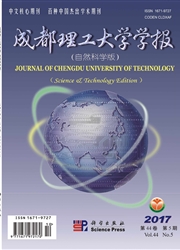

 中文摘要:
中文摘要:
以详细的岩心观察、薄片鉴定及测井分析为手段,对松辽盆地Q区典型的铀矿床进行了剖析。松辽盆地Q区铀矿床是典型的层间氧化带型矿床。研究区砂岩型铀矿床具有在砂-泥结构的灰色砂岩层中成矿,在厚度合适、具薄层富含泥(或碳质)的砂体中富集的典型特征。泥质隔水层的存在使得富含铀元素的流体能在一定范围内稳定流动,而厚度适中且含有一定泥质或碳质的砂层不仅提供了丰富的铀元素吸附剂,同时可使富含铀元素的流体在流动过程中有足够的时间被还原沉淀和吸附,因此,在氧化还原过渡带中,这种具有上下隔水层、厚度适中且含有一定泥质或碳质的砂层是铀元素富集的理想场所。氧化还原带及沉积微相是铀元素能否富集的重要控制因素。
 英文摘要:
英文摘要:
The uranium deposit in Q area of Songliao Basin is anatomized by means of core observation, identification of thin sections and well logging analysis. The uranium deposit belongs to a typical sandstone-type deposit in the interlayer oxidization zones. There are three typical characteristics in the uranium deposit in research area. Firstly, the uranium deposit always exists in a gray sand body which have favorable sand-mud-sand structure. Secondly, the thickness of an ore- bearing sand body is within a specific range. Thirdly, uranium commonly enriches in a sand body that contains some carbon or clay. The existence of several aquifuges can make the liquid rich in uranium flow in a certain range and the sand body with proper thickness and containing some carbon or clay not only offers a great lot of sorbent but also makes the uranium in liquid have enough time to be deoxidized and adsorbed. Therefore, the sand body has the typical characteristics mentioned above is a perfect place for the uranium deposit. The redox zone and sedimentary microfacies are two important controlling factors for the enrichment of uranium.
 同期刊论文项目
同期刊论文项目
 同项目期刊论文
同项目期刊论文
 期刊信息
期刊信息
